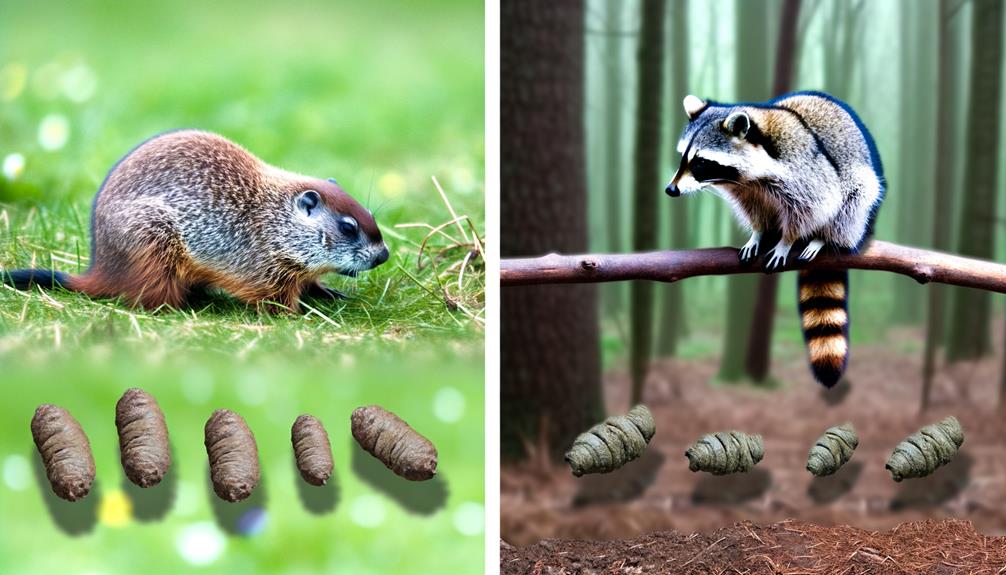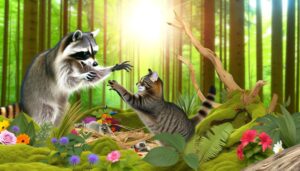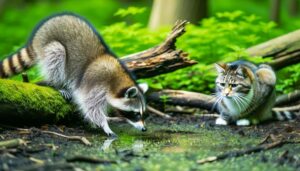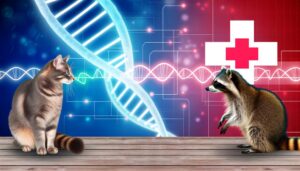10 Key Differences: Groundhog Poop Vs Raccoon Poop
Groundhog and raccoon feces differ drastically because of their distinct dietary habits and behaviors. Groundhogs, primarily herbivores, produce oval-shaped droppings containing visible plant matter.
Conversely, raccoons, as omnivores, leave behind larger, tube-shaped droppings, sometimes containing undigested food particles. It's essential to understand these features to correctly identify each type, especially due to associated health risks like leptospirosis and raccoon roundworm.
Misidentifying can lead to improper handling and potential health hazards. Further exploration into this subject will provide deeper insights and preventative measures for dealing with these animal droppings safely.

Key Takeaways
- Groundhog droppings are oval-shaped with visible plant matter due to their herbivorous diet.
- Raccoons, being omnivores, produce feces that may contain various materials including fruit seeds, insect parts, and even trash.
- Raccoons often use feces for territorial marking, hence their droppings are typically found in communal sites, known as latrines.
- Both types of feces can transmit diseases like leptospirosis, but raccoon feces can also carry the dangerous Baylisascaris procyonis parasite.
- Identification is crucial as coming into contact with either type of feces can pose health risks; immediate washing and protective measures are necessary.
Understanding Groundhog Behavior
To accurately distinguish between groundhog and raccoon feces, one must first understand the behavioral patterns of groundhogs, particularly their feeding and burrowing habits. Groundhogs, or woodchucks, are primarily herbivores, with a diet consisting of a variety of plants, vegetables, and fruits. This dietary preference directly influences the appearance and composition of their feces, which is generally oval-shaped and contains visible plant matter.
Concerning burrowing, groundhogs are known for their extensive tunnel systems. These creatures typically defecate within their burrows, which can limit the visibility of their feces.
Understanding these characteristics is essential to accurately differentiate between groundhog and raccoon feces, enabling individuals to respond appropriately to potential wildlife encounters.
Raccoon Habits Explained
As we shift from the behavior of groundhogs, we now turn our focus to the habits of raccoons.
The following discussion will provide an analysis of their diet and overall behavior, illuminate their nocturnal activity patterns, and provide insight into the significance of their markings.
This detailed overview is intended to facilitate a better understanding of raccoons' unique biology and behavior.
Raccoon Diet and Behavior
Exhibiting a diverse range of dietary habits, raccoons are omnivorous creatures known to consume a variety of foods including fruits, plants, insects, rodents, and waste from human dwellings. This adaptable feeding behavior, coupled with their adaptability to diverse habitats, contributes to their successful proliferation across multiple continents.
Raccoons are opportunistic feeders, exploiting available food resources, including anthropogenic sources. Their diet varies seasonally, with a preference for fruits and nuts in the fall, insects and smaller vertebrates in the spring and summer, and a reliance on human-provided food and stored body fat during winter.
Behaviorally, raccoons are solitary and territorial, with males having larger territories than females. Their cognitive abilities, particularly problem-solving, are highly developed, aiding them in accessing food in complex situations.
Night-Time Activity Patterns
Raccoons, renowned for their adaptive feeding behavior, also exhibit a distinctive nocturnal pattern, primarily active during the night hours. Their crepuscular to nocturnal activity is a survival strategy, reducing the likelihood of predation and competition for resources.
Studies have shown that raccoons adjust their activity patterns in response to environmental factors such as light conditions, temperature, and food availability. For instance, in urban environments, where artificial lighting is prevalent, raccoons may alter their nocturnal behavior to exploit resources more effectively. This flexibility in their activity patterns demonstrates the raccoon's remarkable adaptability to different environments and conditions, a proof of their survival prowess.
However, this nocturnal activity can lead to conflicts with humans, a topic explored further in the next section.
Understanding Raccoon Markings
To fully comprehend raccoon behavior, a critical facet to explore is their unique marking habits, which serve a multitude of functions in their daily lives. Raccoons use their feces and urine to mark territory, signal reproductive status, and communicate with other raccoons.
The table below illustrates these behaviors:
| Behavior | Marking Type | Function |
|---|---|---|
| Territoriality | Feces/Urine | Demarcates boundaries |
| Reproduction | Feces/Urine | Signals readiness to mate |
| Communication | Feces/Urine | Sends messages to other raccoons |
This analysis underlines the complex social structure of raccoons and the remarkable ways they utilize markings to interact with their environment. Understanding these intricacies is key to comprehending the behavior of this fascinating creature.
Groundhog Scat: Key Characteristics
Groundhog scat possesses distinctive features that aid in its identification and can provide insights into the animal's diet and health. The appearance of groundhog droppings, often characterized by size, shape, and color, is a vital factor in distinguishing them from other animal scats.
Additionally, understanding the potential health risks associated with groundhog feces is important for humans and pets who may come into contact with it.
Identifying Groundhog Droppings
In the realm of wildlife scatology, identifying groundhog droppings or 'scat' can be achieved by noting several key characteristics.
Groundhog scat displays a unique texture and size that sets it apart from other creatures. It typically measures around half an inch in diameter and one to two inches in length. The shape is generally cylindrical, akin to a small capsule.
The coloration varies, often appearing dark brown or black, reflecting the groundhog's diet which consists largely of vegetation. The droppings are usually found near the groundhog's burrow, or in areas where they have been foraging.
Groundhog Scat Appearance
Delving deeper into the characteristics of groundhog scat, one notices that its appearance–from texture to coloration–is largely influenced by the animal's primarily herbivorous diet.
Groundhog droppings are typically cylindrical in shape, with a length of approximately one to two inches and a diameter of about half an inch. The color tends to range from green to brown to black, depending on the type of vegetation consumed.
The texture of fresh groundhog scat is somewhat soft but becomes harder as it dries. It is common to find plant material visible within the droppings, a clear indication of their herbivorous eating habits.
Therefore, the distinctive characteristics of groundhog scat allow it to be easily distinguished from that of other species, such as raccoons.
Health Risks Involved
While the distinctive characteristics of groundhog scat aid in its identification, it is equally important to take into account the potential health risks associated with exposure to these droppings.
- Bacterial Infections: Groundhog droppings may harbour harmful bacteria like Leptospira and Salmonella, which can lead to serious illness if contracted.
- Parasitic Transmission: Groundhog feces can potentially transmit parasites such as Giardia or worms, posing a significant health risk, particularly to children and those with compromised immune systems.
- Allergy and Asthma Triggers: Dried groundhog droppings can disintegrate and become airborne, acting as potent allergens and exacerbating respiratory conditions like asthma.
Understanding these risks underscores the significance of proper handling and disposal of groundhog scat, safeguarding both individual and public health.
Identifying Raccoon Droppings
One must be able to distinguish raccoon droppings, as their unique characteristics can provide vital information about the presence and habits of these nocturnal creatures.
Raccoon feces are typically two to three inches long, have a tubular shape, and often display undigested food particles. The color can range from light to dark, depending on their diet.
Additionally, they tend to deposit their droppings at communal sites, known as latrines, often found at the base of trees, on horizontal surfaces, or in abandoned burrows. The droppings can have a strong odor, which can be used as an additional identification marker.
Essentially, understanding these key characteristics allows for a more accurate identification of raccoon droppings, aiding individuals in wildlife management and control.
Health Risks of Groundhog Feces
Groundhog feces, like those of many wildlife species, can act as a vector for disease transmission to humans and other animals. Potential pathogens found in groundhog feces may include bacteria, viruses, and parasites, often varying by geographic location and specific groundhog populations.
To mitigate the associated health risks, a thorough understanding of preventative measures and safety procedures is mandatory.
Disease Transmission Through Feces
Potential health risks can arise from contact with groundhog feces, primarily due to the various pathogens and parasites they may contain. These biological agents are responsible for the transmission of several diseases which can seriously threaten human health.
- Leptospirosis: This bacterial disease is often present in groundhog feces. Exposure can lead to severe kidney damage, meningitis, liver failure, and respiratory distress.
- Raccoon Roundworm: Though more common in raccoon feces, this parasite can also be found in groundhogs. Ingestion or inhalation of eggs can cause serious neurological disorders.
- Giardiasis: This protozoan infection can cause severe diarrhea, dehydration, and abdominal cramps. Groundhogs can act as a reservoir for Giardia, shedding the parasite in their feces.
Understanding these risks is essential for maintaining one's health and well-being.
Prevention and Safety Measures
To effectively mitigate the health risks associated with groundhog feces, a series of prevention and safety measures need to be implemented diligently. Initial focus should be on preventing groundhogs from occupying human habitats by employing humane exclusion techniques such as sealing off potential burrowing sites and installing fences.
In addition, maintaining a clean environment reduces the likelihood of fecal contamination. In case of accidental contact, immediate and thorough washing with soap and water is paramount. Protective clothing should be worn when cleaning areas with groundhog feces.
If contracted, diseases from groundhog feces, like leptospirosis, can be life-threatening. Hence, vaccines and prophylactic treatment should be considered, especially for those in high-risk occupations or environments.
Dangers of Raccoon Excrement
Raccoon excrement, often mistaken for that of smaller mammals, presents significant health risks due to the presence of harmful parasites and diseases. This fecal matter harbors a multitude of dangers, particularly when it is fresh and has not thoroughly dried out.
Baylisascaris procyonis: This roundworm parasite, prevalent in raccoon feces, can cause severe or lethal neurological damage in humans upon ingestion or inhalation.
Leptospirosis: This bacterial disease can lead to kidney damage, meningitis, liver failure, and respiratory complications. It's especially dangerous when the excrement contaminates water sources.
Salmonella: A common bacterial infection, salmonella can be contracted from raccoon feces and can cause diarrhea, fever, and abdominal cramps.
Awareness of these dangers is essential for individuals who value their freedom and health.
Common Misconceptions About Groundhog Poop
While the health risks associated with raccoon excrement are well-documented, misconceptions often surround the fecal matter of another common mammal, the groundhog.
A prevailing misapprehension is that groundhog feces are harmless, which is an oversimplified viewpoint. Though not as dangerous as raccoon feces, groundhog excrement can still harbor parasites like Giardia, which can cause severe gastrointestinal distress in humans if ingested or indirectly contacted.
Another common fallacy is the belief that groundhog feces are easy to identify. In actuality, they closely resemble those of other small mammals, making identification challenging.
Ultimately, the notion that groundhog feces can be handled without protective gear is erroneous and can lead to unintentional exposure to health risks.
Debunking Raccoon Scat Myths
Shifting our focus to the other side of the spectrum, several misconceptions also exist about raccoon scat, demanding careful scrutiny and debunking. The misinformation often leads to unnecessary panic and ill-informed decisions regarding wildlife interaction.
- Myth: Raccoon feces are always hazardous to human health:
While raccoon feces can carry diseases like Baylisascaris or Leptospirosis, not all raccoon scats contain these pathogens. The risk is situational and dependent on various factors, including the raccoon's diet and habitat.
- Myth: Raccoon droppings are easy to identify:
Raccoon feces can vary greatly in appearance, often mistaken for the feces of other animals. Several factors influence this, including diet, age, and health of the animal.
- Myth: All raccoons are rabid:
While raccoons are carriers of rabies, not every raccoon is infected with the virus. Judging a raccoon's health solely based on its feces is not scientifically valid.
How to Safely Handle Wildlife Waste
In the context of managing wildlife feces, it is imperative to understand the correct and safe methods of handling and disposal to prevent potential health risks.
The primary rule is to never handle animal feces barehanded. Always use disposable gloves and a shovel or scooper. The feces should be placed in a sealed bag before disposal. If touched, wash hands thoroughly with soap and water.
Another key aspect is ensuring that the areas frequented by the animals are disinfected with a bleach solution to kill parasites and bacteria.
Expert Tips for Animal Poop Identification
Distinguishing between different types of animal feces, a skill known as scatology, can provide valuable information about the species present in a given area and their behaviors. This method of identification offers a non-invasive way to track and study wildlife, important for both research and conservation efforts.
- Size and Shape: The dimensions and form of feces can often indicate the type of animal. For instance, groundhog feces are typically cylindrical and about half an inch in diameter, while raccoon feces are larger and often contain undigested food particles.
- Location: The site where droppings are found can also provide clues. Raccoons often leave their feces in communal sites called latrines, while groundhogs are more solitary in their habits.
- Contents: The presence of specific materials, such as fur, seeds, or insect parts, can also help in identification.
Conclusion
To sum up, the study of wildlife scat, specifically groundhog and raccoon droppings, provides valuable insight into their behavior and potential health risks. Accurate identification is essential to mitigate hazards and debunk common myths.
Through understanding key characteristics and adopting safe handling methods, human interaction with these creatures can be managed intelligently.
Further, this knowledge contributes to the broader field of wildlife biology, offering a unique perspective into the lives of these intriguing animals.






